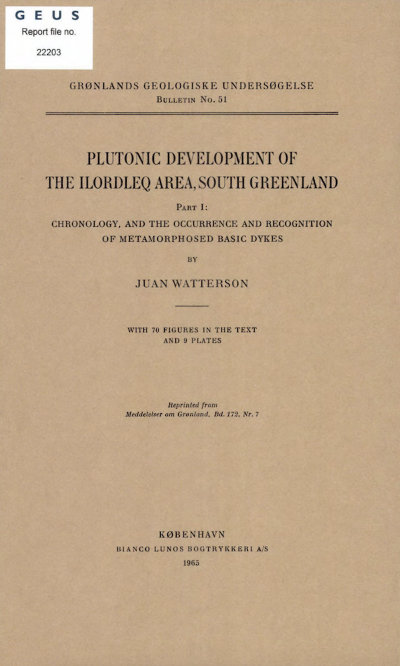Plutonic development of the Ilordleq area, South Greenland. Part I: Chronology, and the occurrence and recognition of metamorphosed basic dykes
DOI:
https://doi.org/10.34194/bullggu.v51.6585Abstract
Evidence is presented which shows the rocks of Ilordleq to be the products of two distinct episodes of plutonic (Read, 1957, p.165) activity. In the first of these episodes the mise-en-place of a large area of synkinematic granitic rocks was affected. A NE striking belt of pre-granite supracrustal rocks is preserved in the north of the area, and isolated remnants of the supracrustal rocks remain as enclaves in the granite. Cutting the metasediments and metavolcanics of the supracrustal group are numerous basic dykes which pre-date the granite. The first plutonic episode was followed by a further period of emplacement of basic dykes, which cut both supracrustal and granitic rocks. Indications of original chilled margins in these dykes, together with their regular form, suggest a marked change in conditions from those prevailing in the preceding plutonic episode. The second period of plutonic activity which followed resulted in a reactivation of much of the granite previously formed, especially in the northern part of the area where basic dykes were deformed and became either disrupted or were migmatised by kinematically controlled metasomatism. The surrounding granite shows evidence of flow in the solid state and was evidently approaching a state in which diapiric movement was possible. In a less reactivated part of the area, porphyroblastic microcline augen granites were formed in those places where the supracrustal enclaves were most strongly deformed. Deformation during each plutonic episode took place by homogeneous strain with resulting change in shape rather than tectonic transport; minor structures in supracrustal, granitic and dyke rocks are homologous. Principal stress axes were similarly oriented during both plutonic episodes. A further period of emplacement of basic dykes took place in the closing stages of the second period of plutonic activity, while the country rocks were still at elevated temperatures and during the operation, at least intermittently, of compressive forces. A conjugate set of shear fractures controlled the emplacement of these dykes; movement along the fractures and emplacement of dykes were essentially contemporaneous and gave rise to 'differentiation by deformation' of the partially consolidated dyke magma, sigmoid foliation of the dykes, and other distinctive features. Further swarms of basic dykes were subsequently emplaced during the Gardar volcanic episode (ca. 1150 x 106 years). Reference is made to published criteria for the recognition of relict dykes, replacement dykes, and dykes emplaced in hot granite, and the possibility of confusion with dykes in reactivated granites is indicated. The suitability of the orogenic cycle as the primary unit of Precambrian chronology is questioned and a less interpretative unit advocated. The Ilordleq chronology is compared with those established by the writer's colleagues elsewhere in South Greenland and possible alternatives suggested to some current correlations. The similarity of many features of the Ilordleq rocks to those of the Lewisian rocks of Scotland is referred to, and the concept of a migrating front of plutonic activity shown to be not applicable to Ilordleq.
Downloads
Published
Issue
Section
License
This article is distributed under a CC-BY 4.0 licence, permitting free redistribution and reproduction for any purpose, even commercial, provided proper citation of the original work. Author(s) retain copyright over the article contents.


